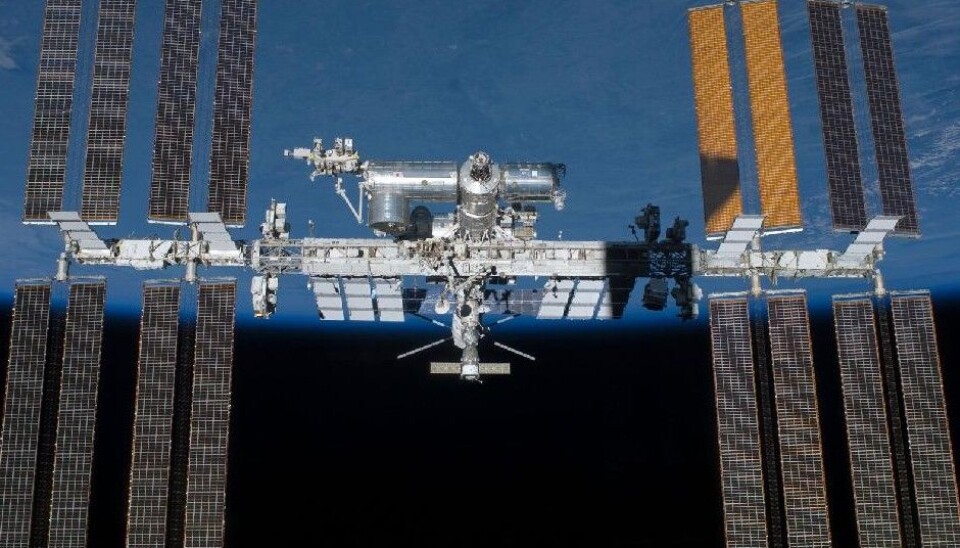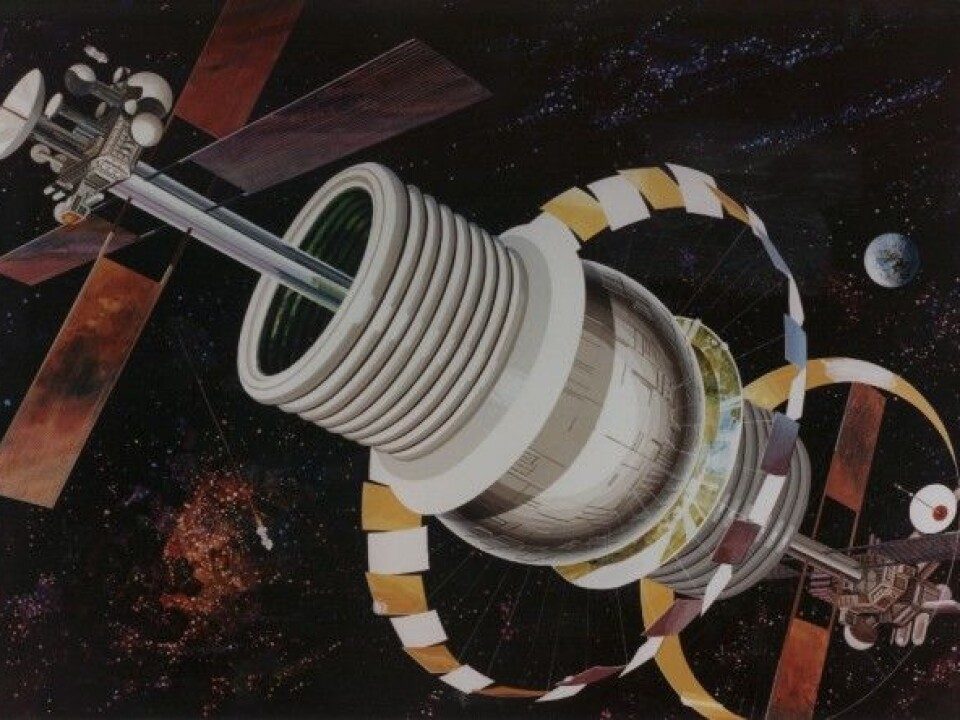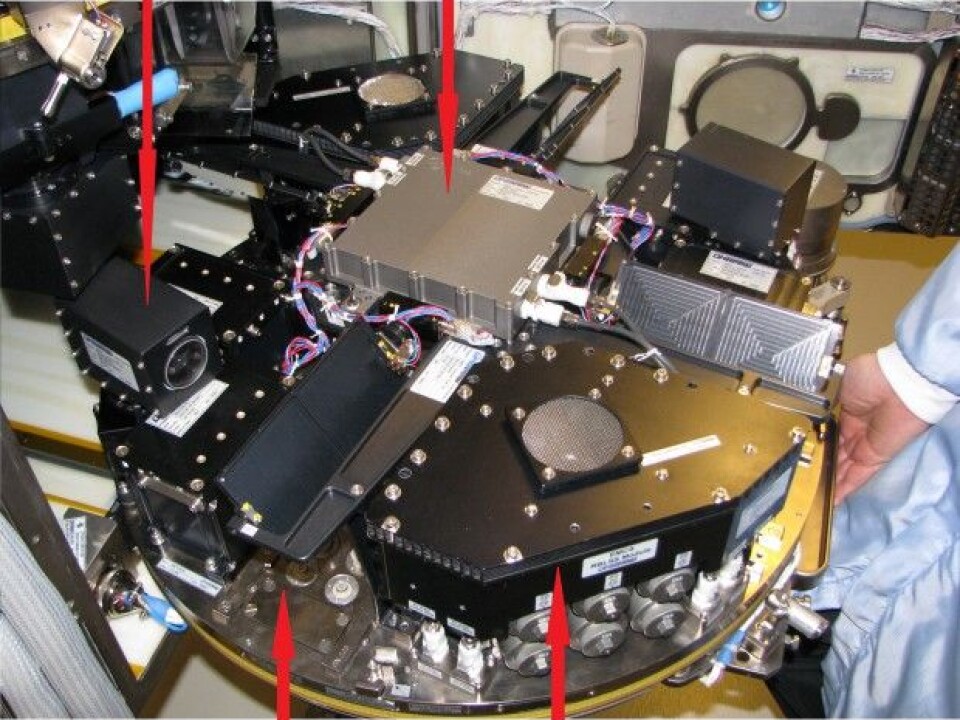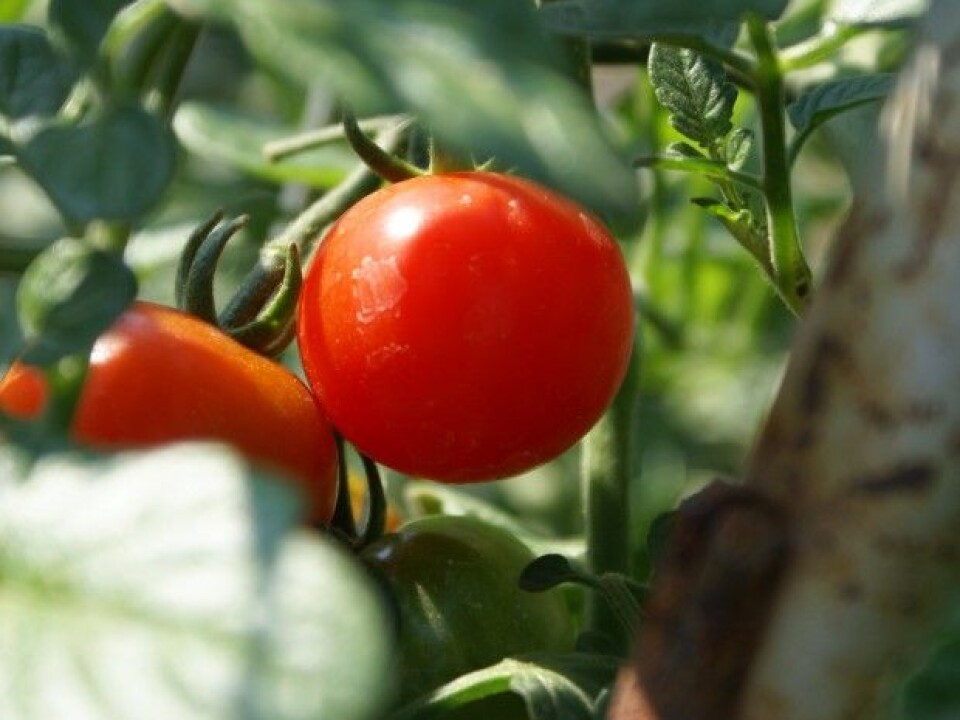
Small steps toward the colonisation of space
Norwegian scientists will cultivate food plants on the Space Station
Denne artikkelen er over ti år gammel og kan inneholde utdatert informasjon.
The colonisation of space could look like this. The illustrations below are from a workshop arranged by NASA at Stanford University in the mid-1970s. Scientists and engineers were asked to come up with ideas about how humans could manage to live far from our planet.
This proposed spaceship is called a Bernal Sphere and could be capable of housing thousands of people. It is colossal. The spherical section in the middle would have a circumference of over 1.5 km
The proposed spaceship would rotate around its lateral axis, creating artificial gravity as centrifugal force slings people and objects out towards the hull. The faster it rotates, the stronger the artificial gravity.
The space colony would have huge living quarters and rings containing agricultural crops could produce oxygen and feed the inhabitants.

Four decades later, as we know, the Bernal Sphere is merely science fiction. It’s a distant dream for optimistic physicists and space researchers. But back in the ‘70s optimists speculated whether the first of such enormous space colonies could be completed between 2002 and 2008, given that construction could commence in 1990.
Cherry tomatoes in space?
The real colonisation of space inches forward with much tinier steps.
“I do envision that what we can form the basis for food cultivation on the Moon and Mars sometime in the future,” says Ann-Iren Kittang Jost, research manager at the Centre for Interdisciplinary Research in Space (CIRiS) at the Norwegian University of Science and Technology (NTNU) in Trondheim.
One of Kittang Jost’s concerns is learning to grow plants on the International Space Station (ISS).

“These are just a few preliminary steps. I don’t want to venture a guess regarding how long it will take before they can be used on a large scale.”
She is now going to lead a new project called TIME SCALE in cooperation with the EU and the European Space Agency (ESA). The main objective is to see how food plants grow in space and how the plants can contribute long-term to supplying space travellers with food and air.
“We haven’t decided which food plant to cultivate yet. We’ve discussed cherry tomatoes, lettuce or soybeans.”
Recycling in space
Humans require quite a lot to survive. An astronaut needs about 30kg of water, food and air altogether daily.

This accumulates over time to many, many tonnes. Even if some water can be recycled, many supplies now have to be sent up from Earth. Each kilo of freight shuttled to the ISS costs thousands of dollars.
If we wish to journey further away from our planet, into space or to other planets, it would be not just ridiculously expensive but physically impractical or outright impossible to maintain a supply chain from Earth.
Such future ventures would have to rely on closed life-support systems. Water, nutrients, air and waste would all have to be recycled in a viable ecosystem – a scaled-down version of what we have on Earth. The ideal would be to recycle everything. We don’t know yet if this is feasible.
Astronauts would need to live on recycled food, water and air, with systems for converting body waste into nourishment.

A key piece of that puzzle is horticulture. Plants convert carbon dioxide and nutrients in soil and water into oxygen and food.
Space is different
But a whole lot needs to be figured out before greenhouses can be constructed in space.
Plant experiments at the International Space Station (ISS) have been run from control room at CIRiS in Trondheim since 2006. The instructions are given from Trondheim but the experiments are implemented in a module aboard the ISS.
Most of the research to date has been on the flowering plant Arabidopsis thaliana. This little weed is a model plant – its entire genome has been charted.
Water, air and stressed plants

The EMCS module is being rebuilt and upgraded so that, among other things, it can used to study how food plants grow under conditions in the ISS.
The space station has a very different environment than fertile soil on Earth. All nutrients to the plants will be meticulously added and monitored. Both air and water behave differently than they do on the planet surface.
“There is no up or down in the microgravity of the space station,” explains Kittang Jost.
“One of the big challenges is to administer exactly the right amount of water and nutrients to the plants in such little gravity.”
There are no currents of air or water in space. Both stay put if no machines are circulating them.
“We have seen that a stationary film of air forms around a plant, so it just stands there ‘breathing’ the same air,” says Kittang Jost.
(In this video you can see Chris Hadfield demonstrate how water behaves in microgravity when he rings out a wet washcloth on the space station.)
At the same time, systems need to be developed and deployed which monitor plant stress. Sensors detect whether a plant emits volatile organic compounds, a plant’s version of a hormone.
“We can see that a plant isn’t getting enough water and thus monitor its health.”
The plants are packed together in a kind of rock, rather than in loose soil.
Pick your gravity, Mars or the Moon?
Like the Bernal Sphere, the old and the new versions of the module have artificial gravity.
So another point of the experiment is to study how plants react to different gravitational conditions.
The plants live and grow in a centrifuge which can be set at different RPMs to mimic gravity on Mars or the Moon. Martian gravity is about a third of ours, whereas lunar gravity is less than a sixth.
“We don’t know much about how food plants behave in these gravities,” says Kittang Jost.
“It is assumed that plants grow okay in lower gravities if we have managed to cultivate them in micro-gravitational conditions, but there is a clear distinction.”
MELISSA
Once a cherry tomato ripens in a prospective greenhouse on a space station or on a lunar base, it will ends up in an astronaut’s stomach.
The astronaut will eventually visit a toilet and the waste will have to be recycled into fertiliser or nutrients for plants or algae, which in turn will use photosynthesis to create oxygen and more food.
This entire self-contained cycle is being tested in the ESA project MELISSA (Micro-Ecological Life Support System Alternative). A demonstration facility featuring such a closed system was opened at the University of Barcelona in 2009 to test and refine prospective technologies.
(Algae research in a MELISSA context can be seen in this video.)
Last summer a photo-bio reactor was launched into space. This is a closed container in which light is used as the energy source for microorganisms which convert carbon dioxide to oxygen.
ESA hopes to put these essential puzzle pieces in place eventually. However, the agency is operating with distant time horizons. According to the long-term plans for MELISSA, a fully functional closed ecosystem will be up and running in space by 2050.
Despite its name, the TIME SCALE project at CIRiS in Trondheim does not have such longevity. The ISS’s service time has recently been extended and according to plan it will remain in operation until the end of 2024.
----------
Read the Norwegian version of this article at forskning.no
Translated by: Glenn Ostling






























